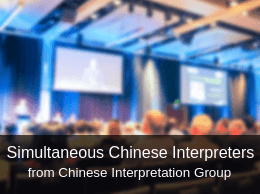Simultaneous interpreters to translate English to Mandarin Chinese, Mandarin Chinese to English as well as multiple other languages…
When your event involves attendees who speak more than one language, accurate and professionally-delivered simultaneous interpretation services can be “make or break.”
Chinese Interpretation Group (CIG) simultaneous interpreters are carefully selected for their advanced language, interpersonal and professional qualities. Many have advanced degrees in interpretation, linguistics, and have highly specialized subject matter knowledge. This level of expertise allows us to source the right linguists and provide the most effective simultaneous interpretation for your event.
These highly skilled interpreters provide simultaneous, consecutive, relay and whispered conference interpretation services for conferences, meetings, legal proceedings and more via onsite or phone interpretation.
At Chinese Interpretation Group (CIG), we have years of experience providing qualified conference interpreters for various Chinese dialects. Our network of skilled Chinese conference interpreters based across India and worldwide have backgrounds in a wide variety of specialist subjects, including law, medicine, technical, engineering and environmental matters, as well as many other fields.
Why choose CIG’s Chinese simultaneous interpreters?
- 100% native speakers
- A network of experienced and highly-qualified translators and Chinese conference interpreters with expertise in a wide variety of specialist fields
- A tailored service to meet your specific needs
- Trusted by a huge number of multi-national organisations and companies worldwide
- A reliable and confidential service
- A global scope with interpreters in locations all over the world
- All forms of interpreting
Which types of interpreting can our Chinese conference interpreters
Two forms of interpreting are required at conferences and Chinese Interpretation Group can provide experienced and specialised interpreters for both requests:
Simultaneous conference interpreting: Two or more interpreters listen to the speaker via a headset and translate simultaneously into a microphone which is connected to the headset of the appropriate audience members. This kind of interpreting requires lots of skill and experience and can be very tiring for an interpreter, which is why it is common for two interpreters to work in partnership sharing the work. Simultaneous interpretation like this is commonly required at conferences that involve several different languages and a large number of participants. It is normally one-way.
Consecutive interpreting: Although less often requested, consecutive interpreting may also be required at conferences. In this case, an interpreter will be asked to assist during things like panel discussions, Q&A sessions or in situations in which an organisation wishes to speak face-to-face with other exhibiting businesses who are set up in stalls around the conference room. This is more likely to be two-way interpreting to facilitate discussion between parties.
About: Chinese
Rather than being one self-contained language, Chinese rather refers to a group of languages officially in use in China, Hong Kong, Taiwan, Macau, Singapore and the Wa State, Burma as well as being recognised as a minority language in the USA, Canada and Malaysia. It is named as one of the six official languages of the United Nations: the variant used in this context being “Standard Chinese”, a standardised version based on the Mandarin spoken in Beijing. The main branches of Chinese are Mandarin, Wu, Yue, of which the main language is Cantonese, and Min. The variations of Chinese are not always mutually intelligible but of the estimated 1.2 billion speakers of some variety of Chinese, around 960 million are thought to speak Mandarin as their native tongue – making it the lingua franca of the Chinese world.
The two official versions of the Chinese language are Mandarin and Cantonese. The People’s Republic of China (mainland China) has Mandarin as its official spoken language. Although Mandarin itself is often used merely as a name for another sub-group of variants, it is the most commonly used version of the Chinese language both in the PRC, Republic of China (Taiwan) and the Republic of Singapore. Cantonese, on the other hand, is widely spoken in the Special Administrative Regions (SAR) of Hong Kong and Macao as well as the Canton (or Guangdong) province of the PRC.
For interpreting assistance regarding any other Chinese dialects, such as Chinese Hainese, Haka, Hmong, Hokkian or Khek, please do not hesitate to contact us directly.
Two forms of written Chinese are widely used. One is known as ‘simplified’ and the other as ‘traditional’. Simplified Chinese was introduced in mainland China by the Chinese government in 1949 for the purpose of improving the literacy rate of the population, and to make complicated characters faster to write (some of which originally included a few dozen strokes). Chinese people on the mainland started using the modern version of characters, while those outside mainland China continued to use the original traditional script.
The major difference between the traditional and the simplified versions of Chinese is that the traditional form includes more complicated characters, whereas the modern simplified characters are regarded as easier to write.
What next?
Call +91-8828165467 or fill the free interpreter booking form for an instant no-obligation free Chinese interpretation quote.
